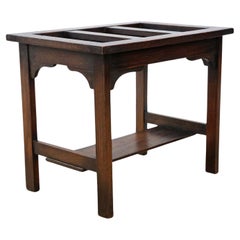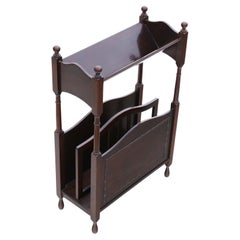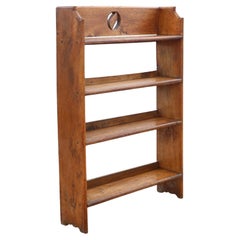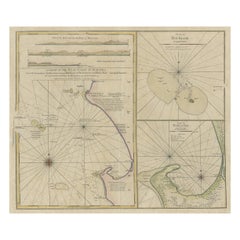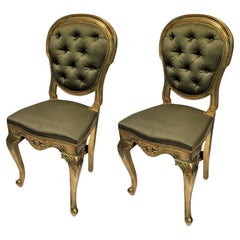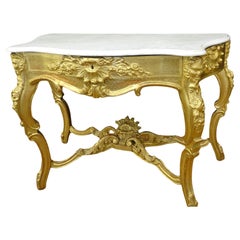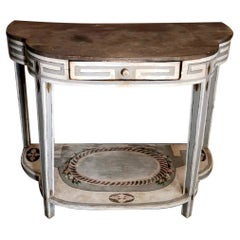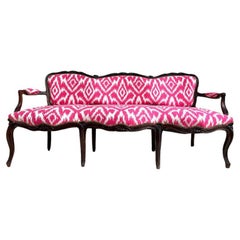Antique Furniture Identifier
to
13
25
12
18
10
9
9
9
7
5
4
3
3
2
2
2
2
1
1
1
1
1
1
1
1
1
1
1
Sort By
Antique Art Nouveau Oak Luggage Stand - Quality Rack from circa 1910
Located in Wisbech, Cambridgeshire
, imperfections, alterations, and repairs, all consistent with the functionality of antique furniture.
Identified
Category
1910s Victorian Antique Furniture Identifier
Materials
Oak
H 18.12 in W 22.05 in D 14.97 in
Antique C1910 Geometric Parquetry Decorated Table Occasional Side Centre Window
Located in Wisbech, Cambridgeshire
, wear, and imperfections, which are generally desirable traits in antique furniture.
Identified by
Category
1910s Antique Furniture Identifier
Materials
Wood
H 27.17 in W 22.05 in D 22.05 in
Antique Art Nouveau Mahogany Bookcase - Quality Book Trough Magazine Stand C1920
Located in Wisbech, Cambridgeshire
antique furniture.
Identified by stock number 8512.
Category
Early 20th Century Antique Furniture Identifier
Materials
Wood
H 27.56 in W 18.12 in D 8.27 in
Antique Victorian Gothic Oak Bookcase Display Cabinet Quality 19th Century
Located in Wisbech, Cambridgeshire
, imperfections, repairs, and alterations, typical of functional antique furniture.
Identified by stock number
Category
19th Century Antique Furniture Identifier
Materials
Oak
H 42.13 in W 29.53 in D 7.49 in
Early Chart Identifying British Spice Trading Colony of Bencoolen, Sumatra, 1797
Located in Langweer, NL
Antique map titled 'A Chart of the West Coast of Sumatra'.
Early nautical chart identifying the
Category
1790s Antique Furniture Identifier
Materials
Paper
H 22.64 in W 27.96 in D 0 in
French Green Pair of chairs in carved and gilded wood, Louis XV style
Located in Valladolid, ES
manufacture of wooden furniture. It is identified with the architectural style called Rococo. Like Rococo, it
Category
Early 1900s French Louis XV Antique Furniture Identifier
Materials
Silk, Giltwood
H 37.8 in W 16.93 in D 15.75 in
French White Marble Gilded wood Console in carved and gilded wood Napoleon III
By French House & Garden
Located in Valladolid, ES
furniture. It is identified with the architectural style called Rococo. Like Rococo, it has profuse
Category
1880s French Napoleon III Antique Furniture Identifier
Materials
Marble
H 35.44 in W 51.58 in D 23.63 in
Louis XV Style French Wood Console Table with White Matte Lacquer Finish
Located in Prato, Tuscany
," but from 1750 until the king's death, a different style of furniture emerged, identified in France as
Category
Mid-18th Century French Louis XV Antique Furniture Identifier
Materials
Wood
H 31.5 in W 39.77 in D 20.87 in
Set of Canapé and Two Bergeres Dom Jose, 18th Century
Located in Lisboa, PT
materials and techniques that D. José furniture emerges. Despite identifying and remaining more faithful to
Category
18th Century Portuguese Antique Furniture Identifier
Materials
Walnut
Fine Antique Rosewood Aesthetic Style Table by Edwards And Roberts/ London
By Edwards & Roberts
Located in Bridgeport, CT
paper label identifying the esteemed furniture house attached to the underside. This fine Aesthetic
Category
Late 19th Century English Aesthetic Movement Antique Furniture Identifier
Materials
Rosewood
H 26 in W 19.25 in D 19.75 in
A Rare Set of Four Louis XV Side Chairs, Stamped Tillard
By Jean-Baptiste Tilliard
Located in Sheffield, MA
-Baptiste and his son used the same stamp to identify their furniture, scholars occasionally have difficulty
Category
18th Century and Earlier French Louis XV Antique Furniture Identifier
Materials
Wood
William IV Mahogany Dining Table, Thomas Treherne 1835-1842
Located in Hoddesdon, GB
)
Also had an address in Newman Street. There is evidence that some furniture bears an identifying
Category
1830s British William IV Antique Furniture Identifier
Materials
Mahogany
Napoleón III , French wood bronze Dresser with mirror
By Napoléon III
Located in Valladolid, ES
cabinetmakers as a result of a major technical advance in the manufacture of wooden furniture. It is identified
Category
1880s French Napoleon III Antique Furniture Identifier
Materials
Bronze
19C Irish Georgian Style Secretary Bookcase
Located in Dallas, TX
(see photos).
Irish Georgian furniture makers wanted to identify their pieces as being ‘Irish’ as
Category
Mid-19th Century Irish George III Antique Furniture Identifier
Materials
Glass, Mahogany, Satinwood
French Auxiliar table, Side table marquetry and marble, Napoleon III
By French House & Garden
Located in Valladolid, ES
as a result of a major technical advance in the manufacture of wooden furniture. It is identified
Category
1860s French Napoleon III Antique Furniture Identifier
Materials
Marble, Ormolu
H 27.96 in W 29.93 in D 18.12 in
19th Century Tennessee American Classical Jackson Press
Located in Forney, TX
material culture.
Identifying furniture made in Tennessee can be difficult, as cabinetmakers signed few
Category
19th Century American American Classical Antique Furniture Identifier
Materials
Cherry, Poplar, Pine
Canoe Paddle with Image of Identified State of Maine Rustic Lodge
Located in North Egremont, MA
Carved pine canoe paddle with exceptional folk scene of the "Norway Pines at Dobsis Lake". The pyrography image depicts the main lodge which was built in 1884 on lake Syla...
Category
Late 19th Century Antique Furniture Identifier
Materials
Wood
Carved Giltwood Console Table
By John Linnell
Located in Sutton Coldfield, GB
allowed several patrons to be traced and individual pieces of furniture to be identified.’ (p.29). Kirkham
Category
1750s English Antique Furniture Identifier
Materials
Siena Marble
18th Century Green Japanned Bureau Bookcase Attributed to Giles Grendey
By Giles Grendey
Located in Lisbon, PT
furniture has been identified, with and without trade labels, to encourage attribution of this bureau
Category
1730s English George II Antique Furniture Identifier
Materials
Oak
H 98.43 in W 42.13 in D 22.84 in
19th Century Pine Welsh Dresser
Located in Mckinney, TX
known as a china hutch in America), is a traditional piece of kitchen furniture identified as such as it
Category
Mid-19th Century Welsh High Victorian Antique Furniture Identifier
Materials
Pine
Commode in Original Neoclassical Style with Bronze Decorations
Located in Prato, Tuscany
, it makes way for a different style of furniture, identified in France as Louis XVI and in the rest of
Category
Mid-18th Century French Neoclassical Antique Furniture Identifier
Materials
Sapele Wood
French Sofa -Canape Luis xv Mink Color, Wood
By French House & Garden
Located in Valladolid, ES
the manufacture of wooden furniture. It is identified with the architectural style called Rococo. Like
Category
1790s French Louis XV Antique Furniture Identifier
Materials
Silk, Wood
French Louis XV Red Checkered Fabric and Carved Wood Bench, Stool
Located in Valladolid, ES
creation of cabinetmakers as a result of a major technical advance in the manufacture of wooden furniture
Category
1780s Antique Furniture Identifier
Materials
Fabric, Wood
c.1920 Eight light Italian Chandelier
Located in Chicago, IL
furniture when it comes to identifying age.
Category
Early 20th Century Italian Antique Furniture Identifier
Materials
Glass
A Very Fine and Rare Tunbridge Ware Octagonal Work Box by Edmund Nye, c1850
By Edmund Nye Tunbridge Wells
Located in Tunbridge Wells, GB
dated by the design of the label (in use from 1848-1853) as identified by the Furniture History Society.
Category
19th Century English Victorian Antique Furniture Identifier
Materials
Walnut
H 2.29 in W 10.56 in D 8.47 in
18th Century George III Harewood and Satinwood Pembroke Table
By Mayhew & Ince
Located in London, by appointment only
the Royal Family has been identified. They provided furniture in 1802 for Hester Thrale Piozzi at
Category
18th Century English George III Antique Furniture Identifier
Materials
Kingwood, Satinwood, Harewood
Louis XV Walnut Commode by Bellanger, circa 1870
By Bellanger
Located in Saint-Ouen, FR
, PARIS ».
BELLANGER S. is identified as carved furniture fabricant and antiques repairer. He settled at
Category
Late 19th Century French Louis XV Antique Furniture Identifier
Materials
Walnut
French chest of drawers, Side table marquetry and marble, Napoleon III
Located in Valladolid, ES
as a result of a major technical advance in the manufacture of wooden furniture. It is identified
Category
1860s Antique Furniture Identifier
Materials
Marble, Ormolu
H 27.96 in W 29.93 in D 18.12 in
American Federal Inlaid Chest of Drawers
Located in Shippensburg, PA
quickly identified in furniture from Lancaster County and some examples from Chester County. Particularly
Category
19th Century American Federal Antique Furniture Identifier
Art Nouveau Antique Oak Bookcase Display Cabinet - Quality C1910 Piece
Located in Wisbech, Cambridgeshire
, imperfections, repairs, and alterations, typical of functional antique furniture.
Identified by stock number
Category
1910s Antique Furniture Identifier
Materials
Oak
H 38.59 in W 30.12 in D 7.09 in
Art Deco Antique Oak Bookcase Display Cabinet - Quality C1920 Piece
Located in Wisbech, Cambridgeshire
, repairs, and alterations, typical of functional antique furniture.
Identified by stock number 8518.
Category
1920s Antique Furniture Identifier
Materials
Oak
How to Identify Old China by Mrs. Willoughby Hodgson, 1903, First Edition
Located in valatie, NY
How to Identify Old China by Mrs. Willoughby Hodgson. London: George Bell & Sons, 1903. Rare first
Category
Early 20th Century English Antique Furniture Identifier
Materials
Paper
Chairs by George Bullock, Set of 4, England, 1816
By George Bullock
Located in Kinderhook, NY
impressive body of documented furniture has been identified, his most important commissions being for
Category
Early 19th Century English Regency Antique Furniture Identifier
Materials
Ebony, Oak, Holly
Martha Washington Chair by Wallace Nutting
By Wallace Nutting
Located in Alexandria, VA
copy of item #2363 in his 2-volume "Furniture Treasury," identified as "Massachusetts, 1795." Block
Category
Early 20th Century American Antique Furniture Identifier
Materials
Mahogany
Rare William IV Circular Mahogany Centre Pedestal Extending Dining Table Stamped
Located in Bradford on Avon, GB
furniture who identified his stock with with a name stamp. Furniture broking certainly formed a branch of
Category
Mid-19th Century English Antique Furniture Identifier
H 29.53 in W 57.09 in D 57.09 in
Rare William IV Circular Mahogany Centre Pedestal Extending Dining Table Stamped
Located in Bradford on Avon, GB
.
It has been generally thought that Thomas Wilson was a dealer in second-hand furniture who identified
Category
1830s English William IV Antique Furniture Identifier
Materials
Mahogany
H 27.96 in W 100.01 in D 57.09 in
A Biedermeier period walnut chest of drawers from Germany c.1830
Located in Houston, TX
furniture is identified with a lighter colour palette of timber compared to what had been seen before when
Category
19th Century German Antique Furniture Identifier
Materials
Walnut
Get Updated with New Arrivals
Save "Antique Furniture Identifier", and we’ll notify you when there are new listings in this category.
Antique Furniture Identifier For Sale on 1stDibs
With a vast inventory of beautiful furniture at 1stDibs, we’ve got just the antique furniture identifier you’re looking for. Frequently made of metal, wood and fabric, every antique furniture identifier was constructed with great care. You’ve searched high and low for the perfect antique furniture identifier — we have versions that date back to the 18th Century alongside those produced as recently as the 20th Century are available. An antique furniture identifier, designed in the Victorian, Regency or Baroque style, is generally a popular piece of furniture. A well-made antique furniture identifier has long been a part of the offerings for many furniture designers and manufacturers, but those produced by Aubusson Manufacture, H&R Daniel and Coalport Porcelain are consistently popular.
How Much is a Antique Furniture Identifier?
Prices for an antique furniture identifier can differ depending upon size, time period and other attributes — at 1stDibs, they begin at $68 and can go as high as $818,658, while the average can fetch as much as $4,140.
Questions About Antique Furniture Identifier
- 1stDibs ExpertMay 30, 2024To identify your antique furniture, look for an engraving, tag, label or other marking that indicates who produced it. You may find it on the bottom or back of your furniture or inside a drawer or cabinet. Once you have located the marking, you can snap a photo of it and use a reverse image search to try and identify the maker. Or, you can type a description of the mark into a search engine. Alternatively, you can use the services of a certified appraiser or antiques dealer to get assistance with identification. On 1stDibs, shop a large selection of antique furniture.
- How do I identify my furniture?2 Answers1stDibs ExpertAugust 17, 2021An easy way to identify your furniture is to look at the manufacturing label, stamp, or tag which shows the name of the creator. There might also be a signature from the furniture maker instead.1stDibs ExpertAugust 24, 2021You can easily identify your furniture by looking over them in areas such as the underside or backside. If there are drawers, you can pull them out to inspect all the sides. A maker’s mark is often placed in these areas. You can also look for identification papers, as they give the location of the factory, date of manufacture, name of the maker and the location of the factory. Find a variety of antique and vintage furniture on 1stDibs.
- 1stDibs ExpertNovember 4, 2024To identify antique Chinese furniture, look carefully at its details. Chinese craftsmen often built furniture using mortise and tenon joinery, eliminating the need for nails and screws. If you see this type of hardware, your piece is likely not at least 100 years old, especially if the hardware still looks new and shiny. Since antique furniture was handmade, you will normally see slight imperfections, such as tool marks or slight variations in carvings. Pieces that appear completely uniform and pristine are less often genuine antiques.
When present, maker's marks can also be helpful. Research the marks to learn more about when the maker was active and producing pieces like yours. Alternatively, you can have a certified appraiser or experienced antique dealer evaluate your furniture for you.
Shop an assortment of antique Chinese furniture. - 1stDibs ExpertNovember 13, 2024To identify old furniture, search inconspicuous areas for maker's marks. Look under seats and tabletops, inside and underneath drawers, on bases and backs and in other hidden areas. Most vintage and many antique furnishings will feature some type of marking, which you can look up using trusted online resources to determine who produced them. When no maker's mark is present, experts recommend consulting a certified appraiser or experienced antique dealer. On 1stDibs, shop a large selection of antique and vintage furniture.
- 1stDibs ExpertNovember 13, 2024To identify Woodard furniture, try to locate the maker's markings. On wrought iron pieces, you will usually find an embossed name on the frame. Other pieces produced by the manufacturer typically have metal tags welded onto their frames or bases. You can find pictures of Woodard maker's marks on trusted online resources and compare the images to your piece. Another option is to have a certified appraiser or knowledgeable antique dealer assist you. Find a range of Woodard furniture on 1stDibs.
- 1stDibs ExpertApril 5, 2022To identify French Empire furniture, look for characteristics of the period. Pieces typically have substantial, weighty silhouettes and ornate details. You will often find Greek and Roman motifs included in their designs. On 1stDibs, shop a selection of expertly vetted Empire furniture.
- 1stDibs ExpertFebruary 13, 2023To identify Lane furniture, look for the manufacturer's mark. On a Lane cedar chest, you'll find it on the bottom. Other pieces may display the marking on the base or back or inside a drawer. Most pieces will also have a serial number. Read the digits from right to left to determine the year of production. For example, a chest that says 850303 indicates that Lane produced the piece on March 30, 1958. In some cases, you may see one extra digit at the end. This number represents the plant that made the piece. If you're unsure about the authenticity of a Lane chest or other furnishing, a certified appraiser can assist you with the identification. On 1stDibs, shop a selection of Lane furniture.
- 1stDibs ExpertMarch 22, 2022To identify Mastercraft furniture, look for the signature features of their designs. The furniture maker often finished pieces in veneers made of exotic hardwoods like burl, fruitwood, yew and amboyna. Brass trim is a characteristic of many of their pieces. Find a range of Mastercraft furniture on 1stDibs.
- 1stDibs ExpertApril 5, 2022Gillows of Lancaster & London was an 18th-century furniture maker who created high-quality wood furniture designs. Many pieces may have a Gillows stamp along with a series of letters and numbers marked under tabletops, along the top edges of drawers or some other hidden spot. The materials used and craftsmanship will also help identify an authentic Gillows piece. When in doubt, work with a certified appraiser to determine the authenticity of your piece. On 1stDibs, you’ll find a variety of expertly vetted antique Gillows furniture.
- 1stDibs ExpertSeptember 23, 2024To identify bamboo furniture, use a magnifying glass to examine the grain pattern on your piece. Bamboo has a distinct grain consisting of short, straight lines and small nodes running in the same direction across a surface. Whirled or irregular grain patterns typically indicate that a piece is wood, not bamboo. If you wish to learn who produced your furniture, search the item for a maker's mark and then use trusted online resources to identify the manufacturer. Should you need any help with the identification process, consider using the services of a certified appraiser or experienced dealer. On 1stDibs, find a collection of bamboo furniture.
- 1stDibs ExpertApril 26, 2024To identify Bassett furniture, look for the maker's stamp. You will usually see it in an inconspicuous area, such as on the underside of a tabletop or seat or on the back or base of a casegood. Some pieces will also bear a style number or serial number. You can cross-reference these numbers with information provided by trusted online resources to learn more about your piece. A knowledgeable dealer or certified appraiser can also help you with the identification process. Shop a diverse assortment of Bassett furniture on 1stDibs.
- 1stDibs ExpertSeptember 23, 2024To identify Dunbar furniture, search your piece for maker's markings. Some pieces feature a D-shaped metal tag, while others bear a metal plaque with the brand name etched on its surface, with or without the company's location: Berne, Indiana. Dunbar also branded its name onto the wood frames of certain furnishings. Upholstered pieces will most likely have the brand name on a label sewn onto a cushion. If you have difficulty locating a maker's mark, a certified appraiser or knowledgeable antique dealer will assist you. Shop a variety of Dunbar furniture on 1stDibs.
- 1stDibs ExpertFebruary 21, 2024To identify Chippendale furniture, first examine its overall shape. Chippendale furniture tends to have curved lines, such as arching arms on chairs and cabriole legs on seating, tables and case goods. Claw feet and batwing hardware are also common features of furnishings in the Chippendale style. The name Chippendale comes from Thomas Chippendale, a well-known London cabinetmaker, and the style was popular in the U.S. during the 16th century. Contemporary furniture designers continue to produce pieces in this style to this day. Find a selection of Chippendale furniture on 1stDibs.
- 1stDibs ExpertJune 6, 2024To identify Salterini furniture, first look for the brand's logo, which should be stamped into the piece in an inconspicuous place. Since this mark has changed over the years, you can compare the stamp on your piece to images shared on trusted online resources to determine its approximate age. Other signs that a particular item is a Salterini include indentations that suggest a piece was hammered by hand and stylistic flourishes such as delicate S-like scrolls on armrests and legs and the maker's signature detail, a tightly woven basketweave effect. If you need help identifying a particular piece, seek the help of a certified appraiser or knowledgeable antique dealer. Shop an assortment of Salterini furniture on 1stDibs.
- 1stDibs ExpertFebruary 27, 2024To identify McIntosh furniture, examine it carefully and look for a maker's mark. Over the years, McIntosh has used three different metal tags to mark the majority of its pieces. Once you've located the one on your piece, compare it to images shared on trusted online resources to determine authenticity. Also, keep in mind that these tags were usually riveted onto the wood rather than glued, so if you don't see visible hardware, a piece may be a replica. Newer furniture may instead display two stickers: one round and one rectangular. Again, you can find photos of these markings online for reference purposes. If you need assistance identifying your furniture, consult a certified appraiser or knowledgeable dealer. On 1stDibs, explore a large collection of A.H. McIntosh furniture.
- 1stDibs ExpertFebruary 7, 2024To identify Victorian furniture, look closely at the details. Victorian furniture is regal, ornate and luxurious. Growing out of the earlier Gothic and Louis XV styles, it came into its own in the mid-1800s, during the reign of Queen Victoria in England. Some key characteristics of furniture from the period include curved lines and stately proportions, floral and geometric patterns, highly detailed embellishments and the use of rich, often exotic woods. If you are unsure whether a particular piece is Victorian, a certified appraiser or knowledgeable antiques dealer can assist you. Find a wide range of Victorian furniture on 1stDibs.
- 1stDibs ExpertNovember 4, 2024To identify Kroehler furniture, search the back, underside, drawer interiors and other inconspicuous areas. Most Kroehler pieces have a stamped or branded maker's mark that bears the Kroehler name. As this mark has changed over the years, comparing the logo and wording on your piece to images published on trusted online resources can help you estimate approximately when it was made. In some cases, the mark may include a production date or a collection name, making a furnishing simpler to identify. If you need assistance with the identification process, consider consulting a certified appraiser or experienced antique dealer. On 1stDibs, explore a selection of Kroehler furniture.
- 1stDibs ExpertNovember 4, 2024To identify Craftsman furniture, first search for a maker's mark on hidden areas, such as the insides and undersides of drawers and under seats and tabletops. If you locate a mark, look it up using trusted online resources to identify the maker of your furniture and research whether they worked in the Craftsman style. Furniture from certain makers, such as Gustav Stickley, Greene & Greene, Roycroft Community, Charles Limbert and Lawrence Peabody, is often Craftsman style. Because many Craftsman pieces are unmarked, familiarize yourself with common characteristics of the style, such as evenly spaced slats, understated round or square drawer pulls, straight lines and exposed dowels and tenons. If you'd like an expert opinion, have a certified appraiser or experienced antique dealer inspect your piece. On 1stDibs, shop a collection of Craftsman furniture.
- 1stDibs ExpertNovember 4, 2024To identify Colonial furniture, first look the piece over from top to bottom. If you see any maker's marks, conduct research using trusted online resources to find out who produced your item and when the maker was in business. Pieces made in the USA between the mid-16th and mid-17th centuries are usually classified as Colonial. Should you be unable to locate a marking, the materials and style can provide clues.
Most Colonial furniture was made of pine, elm, oak, mahogany or walnut wood. During the period, furniture tended to be simple overall, but it did include a few flourishes, such as turned cabriole legs. Because Colonial furniture was handcrafted, furnishings produced during the era usually have visible tool marks and slight irregularities in their carvings. Because there are numerous reproductions of Colonial pieces, you may wish to seek the opinion of a certified appraiser or knowledgeable antique dealer.
On 1stDibs, shop an assortment of Colonial furniture. - 1stDibs ExpertNovember 4, 2024To identify TESSA furniture, look for a maker's marking. Virtually all pieces produced by the Australian maker are marked. On tables, you will normally find the brand name under the tabletop, while chairs typically display the name under the seat. For casegoods, check the back, base and drawer interiors. Upholstered furniture will have a tag sewn onto one of its cushions. If you struggle to locate a marking, a certified appraiser or experienced dealer can help you with the identification process. Shop a variety of TESSA furniture on 1stDibs.
